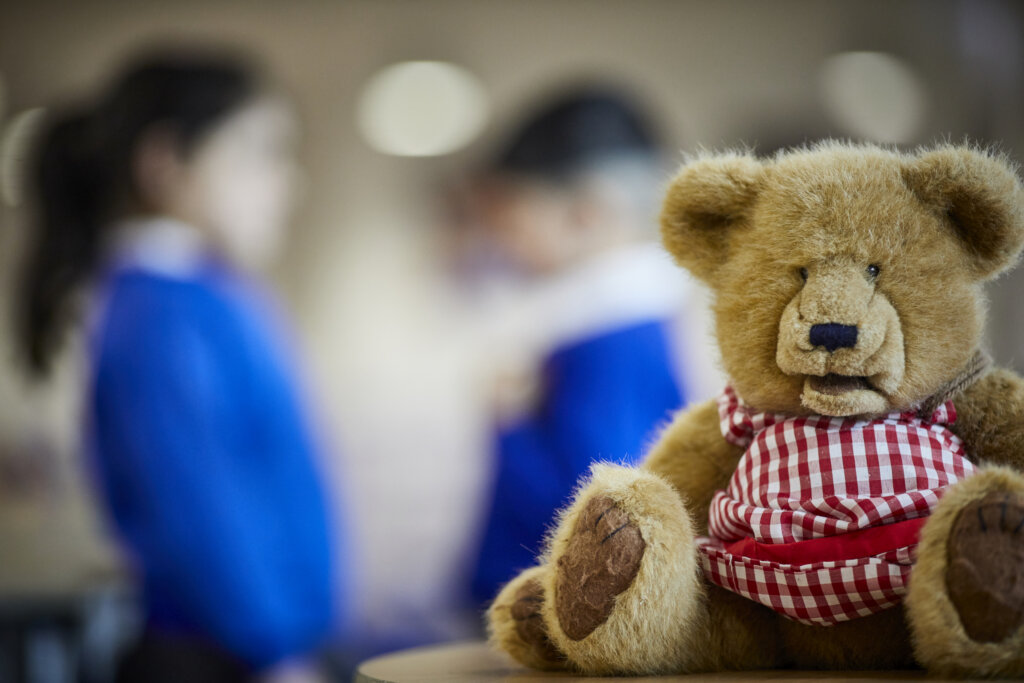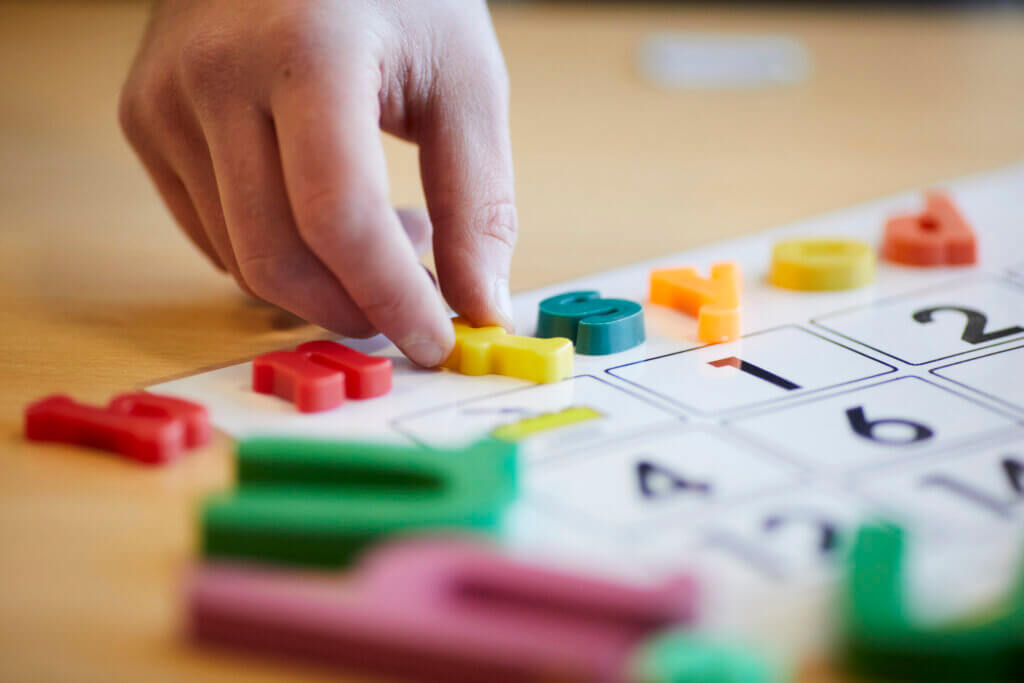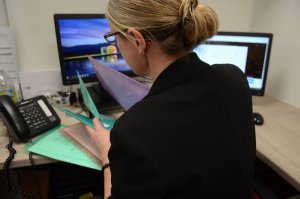We often hear the phrase in Early Years, ‘The Environment is the Third Teacher’ (or practitioner). This has been taken from Reggio Emilia’s philosophy regarding children’s ability to thrive when they are in a space which encourages exploration, experimentation, allows them to develop their own ideas and sense of the world around them. So, how do we ensure that we are regularly evaluating and auditing our environment to check that it meets the developing needs of our children, is an engaging space, and allows for effective and holistic learning to take place?
Auditing your environment may seem like another ‘to-do’ item on your list but it really is crucial to ensure that every single resource in your environment is: accessible, used and levelled.
Accessible
Are the resources and displays within the environment at the children’s height? This is something that we sometimes overlook when we are sticking letters close to the ceiling! Children need to be able to reach, and use, all of the resources within provision and the best way to test this is by getting down to their eye level and make sure that what’s on offer is within touching range. Otherwise, we can end up with things in our environment that become wallpaper; adding to an over cluttered and over stimulating place which is not conducive to effective learning.
Any time that you organise resources or move furniture you must ask yourself, “Can children access everything?” Can they reach the resources on the top of the shelving unit? Is a table pushed against the wall meaning they can’t quite reach that masking tape that is essential for their creation of a mega rocket? Is the book shelf stacked to the brim with books so that each time they want to take one it feels like they’re playing a risky game of Jenga?
Used – are the children engaged in that area?
When is the best time to evaluate if the children are using all areas of the provision? Probably not at the end of the day when you’re frazzled and can’t remember if you actually ate lunch. You need to be doing this whilst the children are in the continuous provision. So, take some time to stand back (encourage all the team to do this too and don`t feel guilty for doing so) then scan the room.
Ask yourself :
- Which areas are the children visiting?
- Which areas are they not?
- What are the children doing in the areas?
- Are they learning?
By observing what children are doing in each area (you might not be able to audit every area in one session) reflect upon if this is what you had expected that children would have been doing. Then ask yourself:
- What resources are they exploring?
- What resources are they not exploring?
- How is this supporting their development?
- What could you add/remove to enhance their learning further?
This is a vital part of your teaching; ensuring that children are using the environment to further their learning. As a team, you can then chat at the end of the day over a cup of tea about what they observed and if any adaptations to provision, or your planning, are needed for the next day to ensure that all areas of learning are used effectively.
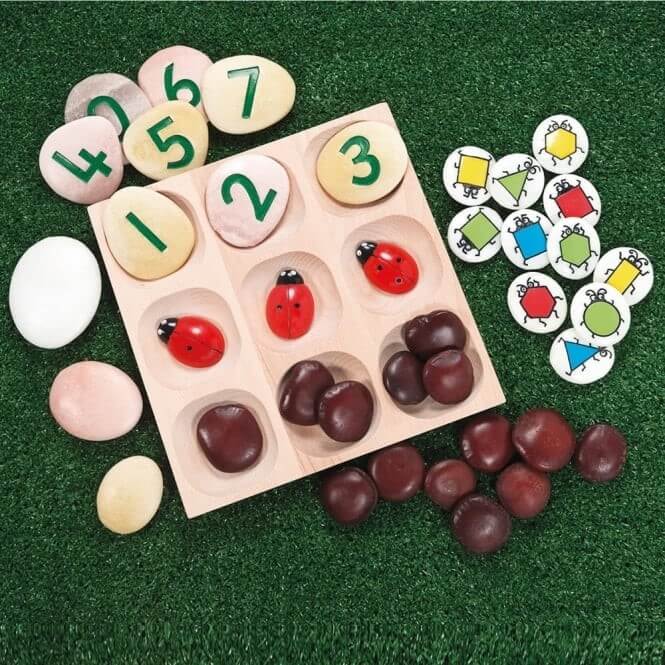
Levelled to support and challenge all learners
For this one, we’ll look at an example area of provision and what this might look like. Let’s think about your maths area. If, based on your assessments, the skill you want to encourage children to practise is counting, then how can the environment support this in multiple ways?
How might you encourage linking the numeral to the value of the quantity?
Display numerals within the area that children can manipulate and match. This could also be dot quantities or tens frame arrangements.
How might you encourage children to predict the amount before counting?
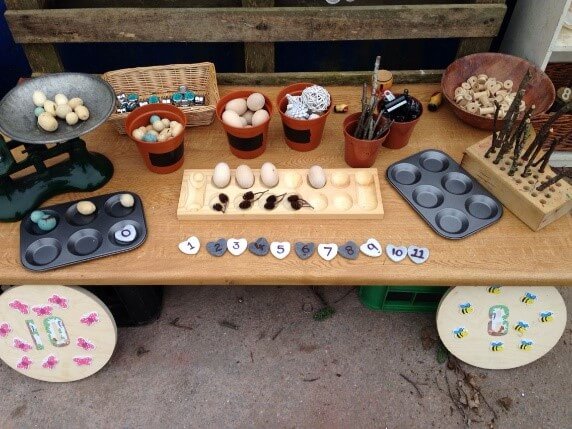
Credit: Pinterest
A suggestion would be to put them in different sized containers and have them say how many before they count. This gives them a purpose for counting.
How might you encourage comparing quantities by counting?
Have a wide selection of counting objects and counting frames – this could simply be a muffin tin and buttons but would encourage a discussion around which is more and how do you know?
How might you link story books and rhymes to counting?
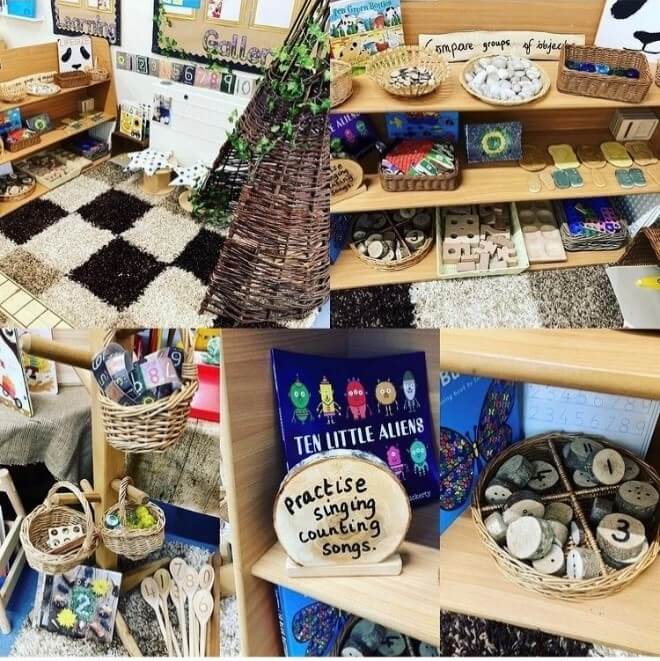
Credit: Instagram (formal_to_continuous_eyfsks1 – St. Clare’s Catholic Primary School in Bradford)
As an enhancement to provision, include high-quality books that involve counting such as Mike Brownlow’s collection of ‘Ten Little…’ or you could add in props for a counting rhyme such as Ten in the Bed using wooden peg people.
Within each area of provision, you then need to consider how are my emergent learners being supported? How are my more advanced children being stretched? Do I have a range of levelled resources that can meet their needs?
In the example above, you will undoubtedly have a range of children who can already count an amount and find the matching numeral and those who cannot. So, how do you support those that cannot? And, extend those that can?
This is where preparation and consideration around the continuum of outcomes is important. As with all areas of development in Early Years, skills over lap so we need to encourage our children to make links and showcase their learning in multiple ways.

Credit: X
Thinking about the continuum of outcomes, at the start of the scale – where you are still supporting counting and recognising numerals – we want to ensure that there are:
- A range of resources that can be counted
- Numerals that children can hold and manipulate
- Stories and songs which feature numerals and counting (as this will help to build those links)
- Application of skills into all areas of play: counting the building blocks, number of bikes outdoors and numerals on the phone in the role play area.
For these children we need to make sure they are seeing, hearing and feeling numbers and numerals in all areas of provision to make the learning stick.
For those who can count confidently and recognise numerals, we want to stretch and challenge these children to deepen and apply their knowledge into other areas of learning.
- Are they ready to record their understanding of how numerals match to quantities? Can they represent a number in different ways? E.g. the written numeral, with dots or using tens frames.
- Are they able to take counting into small world play and exploring ideas such as how many legs are there on the farm? How do you know?
Within all these areas, we need to ensure there are resources for children to record their mathematical ideas so plentiful writing materials and tools will allow them to express their growing mathematical thinking.

Why is it important?
Einstein, said, “Play is the highest form of research.” But why did he say this? When we get the environment right in Early Years wonderful things can happen through play. We provoke awe and wonder with the range of high-quality resources provided. We encourage collaborative play where children can explore their thoughts and beliefs and learn from one another. We build those learning pathways by interconnecting our areas of learning, children then feel confident and secure in taking risks with their own learning. We create, in our children, a lifelong passion for curiosity, creativity, exploration, independence and a love of learning.
To find out more about auditing and improving the provision in your EYFS book your place on our termly EYFS Network Meetings. The next one, on 11th November, will explore how to get the best out of our provision, share the latest updates on the EYFSP and The Reading Framework, along with considering the impact of the pandemic on vocabulary and Oracy in the Early Years. In addition, we will discuss phonics schemes, look at how it’s going with the EYFS Framework, and have the opportunity to catch up with like-minded EYFS colleagues.
For any questions or queries about EYFS, or any other element of School Development, please email harriet.brettell@oneeucation.co.uk







